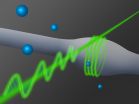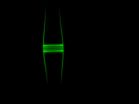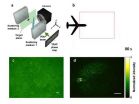(Press-News.org) Two photons in free space do not interact. Light waves can pass through each other without having any influence on each other at all. For many applications in quantum technology, however, interaction between photons is crucial. It is an indispensable prerequisite for transmitting information through tap-proof quantum channels or for building optical logic gates. At the Vienna University of Technology (TU Wien), scientists have now succeeded in establishing a strong interaction between two single photons. This opens up completely new possibilities for quantum optics. The experimental results have now been published in the journal "Nature Photonics".
Interaction Usually Requires Bright Light
"In order to have light interact with light, people have been using so-called nonlinear media", says Professor Arno Rauschenbeutel (Institute for Atomic and Subatomic Physics, TU Wien). The light has an effect on the properties of these materials, and the material in turn influences the light, which leads to an indirect coupling between photons. This technique, however, can only be used at strong light intensities, when countless photons are involved.
At TU Wien, a system was built which creates a strong interaction between only two photons. This interaction is so strong that the phase of the photons is changed by 180 degrees. "It is like a pendulum, which should actually swing to the left, but due to coupling with a second pendulum, it swings to the right. There cannot be a more extreme change in the pendulum's oscillation", says Rauschenbeutel. "We achieve the strongest possible interaction with the smallest possible intensity of light."
A Photon in a Bottle
To make this possible, the photon has to be sent on an unlikely journey. An ultra-thin glass fibre is coupled to a tiny bottle-like light resonator so that light can partly enter the resonator, move in circles and return to the glass fibre. This detour through the resonator leads to the phase of the photon being inverted: a wave crest appears where a wave trough would have been expected.
When, however, a single rubidium atom is coupled to the resonator, the system is changed dramatically. Due to the presence of the atom, hardly any light enters the resonator anymore and the oscillation phase of the photon cannot be inverted.
Two Photons at Once
Things change when two photons arrive at the same time. "The atom is an absorber which can be saturated", says Arno Rauschenbeutel. "A photon is absorbed by the atom for a short while and then released into the resonator. During that time, it cannot absorb any other photons. If two photons arrive simultaneously, only one can be absorbed, while the other can still be phase shifted."
From a quantum mechanical point of view, there is no difference between the two photons. They can only be understood as a joint wave-like object, which is located in the resonator and in the glass fibre at the same time. The photons are indistinguishable. No one can tell which of them is being absorbed and which one has passed. When both hit the resonator at the same time, both of them together experience a phase shift by 180 degrees. Two interacting photons arriving simultaneously show a completely different behaviour than single photons.
The Building Blocks of Future Quantum Data-Highways?
"That way, a maximally entangled photon state can be created", says Arno Rauschenbeutel. "Such states are required in all fields of quantum optics – in quantum teleportation, or for light-transistors which could potentially be used for quantum computing."
A big advantage of the new system is that it is based on glass fibre technology, which is already being used for online communication anyway. Nano glass fibres and bottle-resonators are perfectly compatible with existing technologies. The targeted creation of a strong photon-photon-interaction is an important step towards a worldwide quantum information network for the tap-proof transmission of data.
INFORMATION:
Further information:
Prof. Arno Rauschenbeutel
Insitute for Atomic and Subatomic Physics
Vienna Center for Quantum Science and Technology
TU Wien
Stadionallee 2, 1020 Wien
T: +43-1-58801-141761
arno.rauschenbeutel@tuwien.ac.at
Dr. Jürgen Volz
Insitute for Atomic and Subatomic Physics
Vienna Center for Quantum Science and Technology
TU Wien
Stadionallee 2, 1020 Wien
T: +43-1-58801-141739
juergen.volz@tuwien.ac.at END
Two photons strongly coupled by glass fiber
At the Vienna University of Technology, 2 photons have been made to interact strongly using an ultra-thin glass fiber; This technique is an important new tool for quantum technology
2014-11-02
ELSE PRESS RELEASES FROM THIS DATE:
Improving imaging of cancerous tissues by reversing time
2014-11-02
As a child, it was fascinating to put a flashlight up to our palms to see the light shine through the hand. Washington University in St. Louis engineers are using a similar idea to track movement inside the body's tissues to improve imaging of cancerous tissues and to develop potential treatments.
Lihong Wang, PhD, the Gene K. Beare Distinguished Professor of Biomedical Engineering at the School of Engineering & Applied Science is applying a novel time-reversal technology that allows researchers to better focus light in tissue, such as muscles and organs.
Current ...
Mutant models
2014-11-02
Nate Silver and Richard Feynman walk into a bar and bump into a biologist . . .
While this may sound like the setup to some late-night nerd sketch, researchers have taken this premise and applied it to an increasingly cumbersome problem in modern biology, namely, finding meaning in the rising oceans of genomic data.
In this specific instance, the data comprisesreams of cancer mutations that genome-wide studies are publishing at a dizzying rate. The challenge is finding new and efficient ways to parse the signal from the noise (and there is no shortage of noise).
As ...
Ultracold disappearing act
2014-11-02
A disappearing act was the last thing Rice University physicist Randy Hulet expected to see in his ultracold atomic experiments, but that is what he and his students produced by colliding pairs of Bose Einstein condensates (BECs) that were prepared in special states called solitons.
Hulet's team documented the strange phenomenon in a new study published online this week in the journal Nature Physics.
BECs are clumps of a few hundred thousand lithium atoms that are cooled to within one-millionth of a degree above absolute zero, a temperature so cold that the atoms march ...
New technique efficiently turns antibodies into highly tuned 'nanobodies'
2014-11-02
Antibodies, in charge of recognizing and homing in on molecular targets, are among the most useful tools in biology and medicine. Nanobodies – antibodies' tiny cousins – can do the same tasks, for example marking molecules for research or flagging diseased cells for destruction. But, thanks to their comparative simplicity nanobodies offer the tantalizing prospect of being much easier to produce.
Unfortunately, their promise hasn't been fully realized, because scientists have lacked an efficient way of identifying the nanobodies most closely tuned to their ...
'Invisible tattoos' could improve body confidence after breast cancer radiotherapy
2014-11-02
Invisible tattoos could replace the permanent dark ink tattoos used to ensure that breast cancer patients having radiotherapy are treated in exactly the same spot during each session, according to results from a pilot study to be presented at the National Cancer Research Institute (NCRI) Cancer Conference today (Sunday)*.
Research suggests that the permanent pin prick marks made on the skin of women having radiotherapy reminds them of their diagnosis for years to come, reducing body confidence and self-esteem.
It's also more difficult to spot these tattoos in dark-skinned ...
Step towards blood test for many cancer types
2014-11-02
Scientists have identified more than 800 markers in the blood of cancer patients that could help lead to a single blood test for early detection of many types of cancer in future, according to research presented at the National Cancer Research Institute (NCRI) Cancer Conference in Liverpool today (Sunday).
This is the first time that cancer-specific blood markers have been comprehensively reviewed and identified for further clinical development. This study, by the UK Early Cancer Detection Consortium*, funded by Cancer Research UK, has analysed 19,000 scientific papers ...
JNS: Pediatrics publishes guidelines for the treatment of pediatric hydrocephalus
2014-11-01
Charlottesville, VA (November 1, 2014). The Journal of Neurosurgery Publishing Group is pleased to announce today's publication of "Pediatric hydrocephalus: systematic literature review and evidence-based guidelines," a supplement to the November issue of the Journal of Neurosurgery: Pediatrics. Authored by a volunteer task force from the pediatric neurosurgery community, the supplement offers a thorough evaluation of the current treatments for pediatric hydrocephalus as well as up-to-date evidence-based recommendations for their use.
Hydrocephalus is a condition in which ...
More penalties on the way for hospitals that treat the poor? New U-M study suggests so
2014-11-01
ANN ARBOR, Mich. – Last week, the federal government revealed that it will fine more than 2,600 hospitals in the coming year, because too many Medicare patients treated at these hospitals are ending up back in the hospital within 30 days of going home. Two new conditions have been added in this round of penalties: elective hip and knee replacement and chronic lung disease.
Now, a new University of Michigan analysis shows that penalties for chronic lung disease will have a greater impact on hospitals that care for poor and minority patients. The findings are published ...
Cancer cell fingerprints in the blood may speed up childhood cancer diagnosis
2014-11-01
Newly-identified cancer cell fingerprints in the blood could one day help doctors diagnose a range of children's cancers faster and more accurately, according to research* presented at the National Cancer Research Institute (NCRI) Cancer Conference next week.
The researchers, from the University of Cambridge and Addenbrooke's Hospital in Cambridge, found unique molecular fingerprints for 11 types of children's tumours,** which could be used to develop blood tests to diagnose these cancers.
This may eventually lead to a quicker, more accurate way to diagnose tumours, ...
Study of Chile earthquake finds new rock structure that affects earthquake rupture
2014-11-01
Researchers from the University of Liverpool have found an unusual mass of rock deep in the active fault line beneath Chile which influenced the rupture size of a massive earthquake that struck the region in 2010.
The geological structure, which was not previously known about, is unusually dense and large for this depth in the Earth's crust. The body was revealed using 3-D seismic images of Earth's interior based on the monitoring of vibrations on the Pacific seafloor caused by aftershocks from the magnitude 8.8 Chile earthquake. This imaging works in a similar way to ...
LAST 30 PRESS RELEASES:
Exploring how patients feel about AI transcription
Category ‘6’ tropical cyclone hot spots are growing
Video: Drivers struggle to multitask when using dashboard touch screens, study finds
SLU research shows surge in alcohol-related liver disease driving ‘deaths of despair’
Rising heat reshapes how microbes break down microplastics, new review finds
Roots reveal a hidden carbon pathway in maize plants
Membrane magic: FAMU-FSU researchers repurpose fuel cells membranes for new applications
UN Member States pledge to increase access to diagnosis and inhaled medicines for the 480 million people living with COPD
Combination therapy shows potential to treat pediatric brain cancer ATRT
Study links seabird nesting to shark turf wars in Hawai‘i
Legal sports betting linked to sharp increases in violent crime, study finds
Breakthrough AI from NYUAD speeds up discovery of life-supporting microbes
New Eva Mayr-Stihl Foundation funding initiative boosts research at University of Freiburg on adaptation of forests to global change
The perfect plastic? Plant-based, fully saltwater degradable, zero microplastics
Bias in data may be blocking AI’s potential to combat antibiotic resistance
Article-level metrics would provide more recognition to most researchers than journal-level metrics
Satiety’s little helper: Protein that supports appetite regulating protein identified
UF dives deep into predicting storm damage with computer models
A stormy ocean voyage yields insights on the global carbon cycle
Scientists identify first non-coding gene that controls cell size
Demonstration of altermagnetism in RuO₂ thin films -- A new magnetic material for the AI era
Penn researchers awarded $25M to conduct trial using smartphones to fight heart disease
PCORI awards funding for new patient-centered healthcare research
Exploring the origins of the universe: 145 low-noise amplifiers complete ALMA telescopes
Empress cicada wings help illuminate molecular structure
Using sound waves to detect helium
Time burden in patients with metastatic breast and ovarian cancer from clinic and home demands
Researchers discover bias in AI models that analyze pathology samples
Scientists ID potential way to prevent brain injuries from triggering Alzheimer's
MASTER 2nd Open Call: Execution period kick-off
[Press-News.org] Two photons strongly coupled by glass fiberAt the Vienna University of Technology, 2 photons have been made to interact strongly using an ultra-thin glass fiber; This technique is an important new tool for quantum technology




